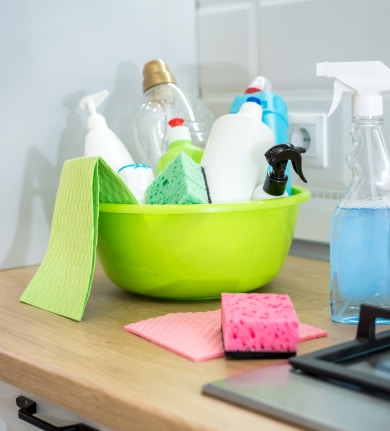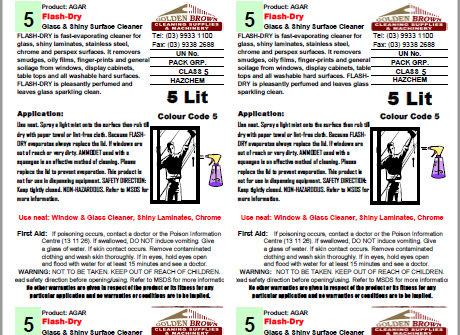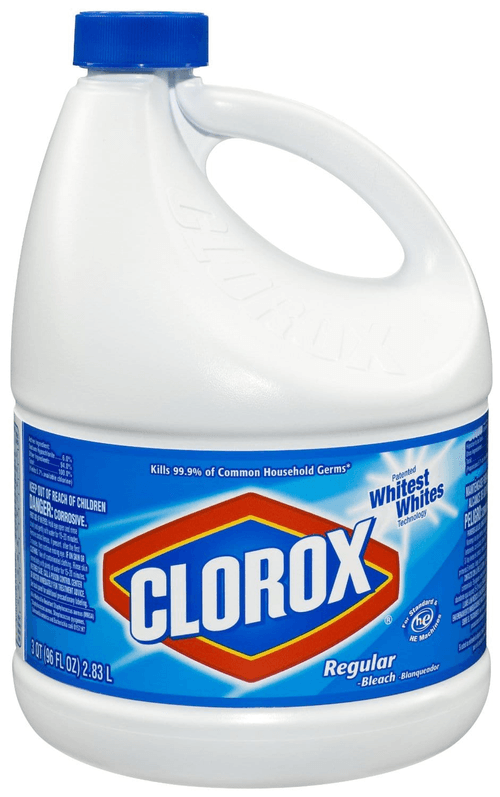43 cleaning chemical labels should contain
Identifying Greener Cleaning Products | US EPA To make it easier for purchasers to identify greener cleaning products, EPA manages the Safer Choice program, which certifies products that contain safer ingredients for human health and the environment. In addition to the Safer Choice label, EPA offers the Design for the Environment (DfE) label on antimicrobial products, such as disinfectants ... How to Properly Contain Chemicals - Cleaning & Maintenance Management Preventing Leaks and Chemical Reactions. There are many ways to properly containerize or package hazardous waste items. One option is to store them in a bin and individually place items in sealed plastic bags. This will prevent items from mixing together and causing a reaction.
PDF Protect Yourself: Cleaning Chemicals and Your Health Sufficient ventilation (airflow) when using cleaning chemicals. Protective clothing, gloves, and safety goggles, when needed. Labels on containers of cleaning chemicals. Training on the hazards of cleaning chemicals you are using and safe work practices. Your employer must train you to: Know the hazards of cleaning chemicals BEFORE using them.
Cleaning chemical labels should contain
Labels 101: How to Read a Cleaning Product Label • Healthy Child ... Few product labels are more difficult to decode than those on conventional cleaning products. This is troubling because cleaners (even those labeled "green" ) frequently contain hazardous chemicals. The information—or lack thereof—on their labels can be the difference between health and illness. How to Read a Cleaning Product Label - The Spruce What the Label Will Say. Most cleaning products add a caution section to their label. It's often in large print and in bold. Most caution warnings will say if the product is an eye irritant, a skin irritant, harmful if swallowed, has contents under pressure, or needs to be used in a well-ventilated area. Chemical Container Labels | EHS As of June 1, 2015, labels on chemicals/products shipped from the manufacturer must be consistent with the Globally Harmonized System of Classification ... The Hazard Communication Standard requires secondary chemical container labels contain at least the following information: Identity of the contents (spell out chemical names) Signal word, if ...
Cleaning chemical labels should contain. Spring Cleaning - Poison A clean home provides a healthy environment for your family, but household cleaning products can contain hazardous chemicals. Acid, alkali, ... Always read the directions for use on cleaning product labels to avoid poisoning or injury. Never mix household cleaning products. Doing so can result in poisonous fumes and serious breathing problems. Cleaning Products That Are Dangerous to Pets - The Maids Here are a few ammonia-based cleaning products toxic to dogs, cats, and other animals: Tile cleaners. Glass cleaners. Carpet cleaners. Wood cleaners. Vinyl cleaners. Disinfectants. Multi-purpose cleaners. Don't do more harm than good when you're cleaning and disinfecting around pets. Cleaning Product Labels | CS Labels Cleaning product labels are usually required to be durable due to the environment in which they are used as well as being able to withstand the chemical content potentially spilling onto the label. The recommendation would be a white gloss PP with a laminate for a corrosive product, for example, a bleach label. Terms to avoid on a hazard label - HSE Terms to avoid. You should also avoid using statements such as 'safe', 'non-harmful', 'non-toxic', 'non-polluting', 'ecological', 'eco' on the labels of substances or mixtures which have been classified as hazardous. Any other statements that are inconsistent with or contradict the classification of the substance or mixture being placed on the ...
Cleaning Chemical Safety Information Types of Cleaning Products. OSHA explains that there are three main types of chemical cleaning products: cleaners, sanitizers and disinfectants.. Cleaners are the most basic type of cleaning agent and remove dirt through wiping, mopping and scrubbing. Sanitizers, which may be required for some tasks by public health codes, contain chemicals that reduce the amount of viruses, bacteria and molds ... WHMIS 1988 - Labelling Requirements : OSH Answers The Hazardous Products Act and the Controlled Products Regulations specify, among other things, what suppliers and importers are required to do with respect to MSDSs and labels. Section 20 of the Controlled Products Regulations prescribes label design requirements for supplier labels and Schedule III has a picture of how the label should look. PDF HazardousChemicals 102016 for pdf - Relias LABELS Chemical manufacturers must label every container of hazardous chemicals. The format will differ from company to company, but the labels must contain similar types of information. • All chemical containers MUST be labeled. • If you pour a chemical from a larger container into a smaller one, the smaller container MUST still be labeled. Product Chemical Hazard Labels Explained - VIP Clean Most household cleaning labels will contain at least one of the pictograms explained above, because many products were made before the new legislation took effect. Children should work with chemicals (including household cleaning products) in a well ventilated area and always under the direct supervision of an adult.
How to Read Food Labels and Avoid Toxic Ingredients The "Clean label Ingredients" is a marketing phrase to replace "all natural.". There are many MSG "clean label" ingredients identified by Truth in Labelling.org that you should be aware of. The list includes, but is not limited to the following substances: Glutamate. Glutamic acid. PDF U.S. EPA, Pesticide Product Label, CONTAIN HERBICIDE, 07/21/1987 PHYSICAL J\ND CHEMICAL HAZARDS Spray solutions of COOTAIN should be mixed, stored and applied only in stainless steel, fiberglass, plastic and plastic-lined steel containers. 00 1m mix, store or apply COOTAIN or spray solutions of cq.rrA.'!:N in unlined steel (except stainless steel) containers or spray tanks. ENVIROOMENTAL IlAZA!U)S Cleaning chemicals: Know the risks | 2017-11-26 | Safety+Health Breathing problems. Itchy skin, rashes and burns. Irritated eyes. For some workers, including maintenance workers, janitors and housekeepers, these symptoms may have a common factor: cleaning products. Chemicals in certain cleaning products also can cause asthma or trigger asthma attacks, OSHA cautions, adding that "some cleaning products contain hazardous chemicals that can enter the body ... Cleaning Supplies and Household Chemicals - American Lung Association Many cleaning supplies or household products can irritate the eyes or throat, or cause headaches and other health problems, including cancer. Some products release dangerous chemicals, including volatile organic compounds (VOCs). Other harmful ingredients include ammonia and bleach. Even natural fragrances such as citrus can react to produce ...
How To Read Labels and Avoid Toxic Cleaning Products Additionally, avoid products that list their ingredients by category ( (i.e. surfactant, disperal agent, or inert ingredient) rather than by their full name. • Be suspect of products where the chemical is given without any further explanation. Look for products where the labels help explain the origins and source of the ingredient.
A List of Chemicals I Try to Avoid in Cleaning Products Reading labels is the best way to avoid spraying toxic chemicals around your home. It is also an easy way to spot greenwashing from brands calling themselves natural, plant-based or eco-friendly. ... Despite being labelled as a single word, fragrances can contain up to 200 chemicals. Even if cleaning products, perfume is classed as a trade ...
osha - HAZARD COMMUNICATION Flashcards - Quizlet Chemical labels must contain a product identifier, signal word and a pictogram to represent the hazards. What other information is required on a chemical label? ... Contact Information. Howard is working with a cleaning solution that contains sodium hydroxide. Although he is using gloves, when he pours the solution to dilute it for cleaning use ...
Chemical Labelling Requirements | Environmental Health & Safety ... Labels on purchased chemicals must include: The common name of the chemical. The name, address and emergency phone number of the company responsible for the product. An appropriate hazard warning. The warning may be a single word - "danger", "warning" and "caution" - or may identify the primary hazard, both physical (i.e., water ...
Warning Labels (Hazardous/Chemical) - Safety on the Set What You Can Find on a Warning Label. the name of the chemical. the name, address and telephone. number of the manufacturer or importer. the chemical code number. one of three signal words indicating the danger level of the chemical: "Warning," "Caution" or "Danger". the word "Poison" if the chemical is highly toxic.
Do my cleaning products contain hormone disruptors? Endocrine disruptors, or 'endocrine-disrupting compounds' (EDCs), are chemicals that can alter hormone signaling. There is concern that the prevalence of these chemicals may have negative, and unpredictable effects on a range of body systems, including [1]: Thyroid function. Nervous system.
Secondary Containers | Environmental Health, Safety and Emergency ... Except for a few cases, secondary containers must be labeled. IF IN DOUBT, LABEL IT! One common case where you do not have to label a secondary container is if the container is portable and will be used immediately by the person who transferred the chemical into that container. For example, if you pour a concentrated disinfectant into a bucket ...
Chemistry Behind Cleaning - How Do Household Cleaners Work? Modern cleaning products may contain a number of toxic chemicals, like phthalates found in fragranced air freshener and dish soap, considered known endocrine disruptors; perchloroethylene or "perc," a neurotoxin found in stain remover and carpet cleaner; and the powerful irritant ammonia found in glass cleaner and bathroom polish, known to affect sufferers of asthma and respiratory issues.
OSHA requirements for cleaning chemicals. | Occupational Safety and ... The product literature you sent us states that "material safety data sheets are available," which would indicate that the chemical manufacturer has performed a hazard determination on the product and has found it to contain hazardous chemicals, since he has produced and has available a MSDS (no MSDS is required if the product does not contain ...
Labelling and packaging - Chemical classification - HSE Labelling and packaging. Labels are there to help identify hazardous chemicals and explain what the hazards are and how to avoid them. Packaging is also important to ensure that chemicals are stored and disposed of safely. Telling others about the classification: the hazard label. [1] Hazard statements, precautionary statements and signal words.
PDF BRIEF - Occupational Safety and Health Administration Labels must also provide instructions on how to handle the chemical so that chemical users are informed about how to protect themselves. The label provides information to the workers on the specific hazardous chemical. While labels provide important information for anyone who handles, uses, stores, and transports hazardous chemicals, they are
Chemical Container Labels | EHS As of June 1, 2015, labels on chemicals/products shipped from the manufacturer must be consistent with the Globally Harmonized System of Classification ... The Hazard Communication Standard requires secondary chemical container labels contain at least the following information: Identity of the contents (spell out chemical names) Signal word, if ...
How to Read a Cleaning Product Label - The Spruce What the Label Will Say. Most cleaning products add a caution section to their label. It's often in large print and in bold. Most caution warnings will say if the product is an eye irritant, a skin irritant, harmful if swallowed, has contents under pressure, or needs to be used in a well-ventilated area.
Labels 101: How to Read a Cleaning Product Label • Healthy Child ... Few product labels are more difficult to decode than those on conventional cleaning products. This is troubling because cleaners (even those labeled "green" ) frequently contain hazardous chemicals. The information—or lack thereof—on their labels can be the difference between health and illness.












Post a Comment for "43 cleaning chemical labels should contain"